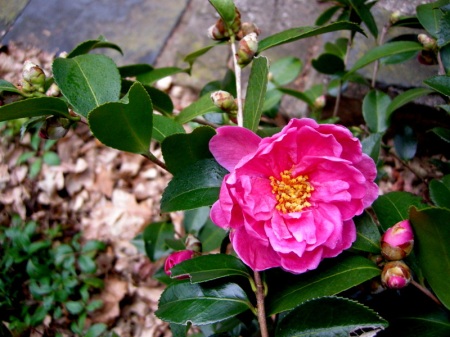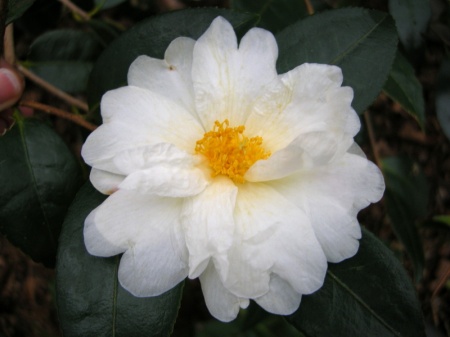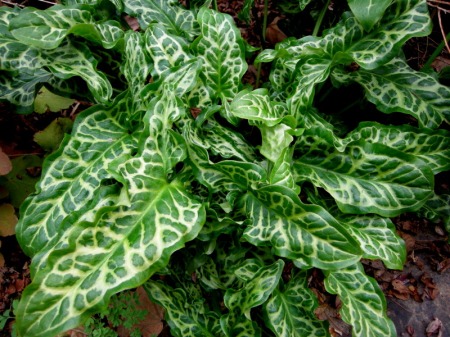Carolyn’s Shade Gardens is a retail nursery located in Bryn Mawr, PA, specializing in showy, colorful, and unusual plants for shade. The only plants that we ship are snowdrops and miniature hostas. For catalogues and announcements of events, please send your full name, location, and phone number (for back up use only) to carolyn@carolynsshadegardens.com. Click here to get to the home page of our website for catalogues and information about our nursery and to subscribe to our blog.
 The first of my hybrid hellebores is just about to bloom: Helleborus x ‘Snow White’ (aka ‘Snow Bunting’).
The first of my hybrid hellebores is just about to bloom: Helleborus x ‘Snow White’ (aka ‘Snow Bunting’).
I am two days late for the official Garden Blogger’s Bloom Day. On the fifteenth of each month garden bloggers from all over the world post photos of what’s blooming in their gardens, and their posts are collected by Carol at May Dreams Gardens. Nevertheless, I thought it would be fun to see which plants are pretty enough to get me outside in December on a somewhat warm but dreary, rainy day. I also wanted to add a new twist by allowing myself only one pass through the garden for photos instead of the numerous trips required by a normal post.
Not surprisingly if you read my blog, Italian arum, hellebores, snowdrops, camellias, hardy cyclamen, and coral bells are hogging the show this time of year accompanied by a few others. Let’s see what we have:
 Fall-blooming camellia ‘Winter’s Snowman’ has been blooming since October and still has buds waiting to open.
Fall-blooming camellia ‘Winter’s Snowman’ has been blooming since October and still has buds waiting to open.
My late fall garden has been immensely improved by the addition of fall-blooming hardy camellias. All five of mine are blooming now and have plenty of buds left. For more information on fall-bloomimg camellias, click here.
.
.
.
Italian arum is always a highlight this time of year after its fresh foliage emerges from dormancy in early fall:
.
.
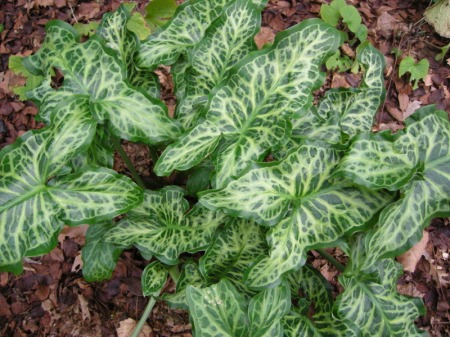 ‘Gold Rush’ Italian arum, my favorite
‘Gold Rush’ Italian arum, my favorite
Hellebores are just about to take over as the stars of the garden for the next few months. For more information on hellebores, click here and follow the links at the end of the post. If it wouldn’t violate my parameter for this post, I would run out and photograph bearsfoot hellebore and ‘Praecox’ Christmas rose, which are both almost open. As it is, I have these two hellebores for you:
 Another shot of the first flower on ‘Snow White’.
Another shot of the first flower on ‘Snow White’.
.
 After blooming in October, ‘Josef Lemper’ Christmas rose is at it again and will continue to bloom into spring.
After blooming in October, ‘Josef Lemper’ Christmas rose is at it again and will continue to bloom into spring.
.
My favorite coral bells or heucheras are the cultivars that give me 365 days of colorful foliage, some of which are pictured below. If I could go back outside, I would add ‘Frosted Violet’ and ‘Bronze Wave’. I would also include some photographs of pulmonarias, especially ‘Diana Clare’:
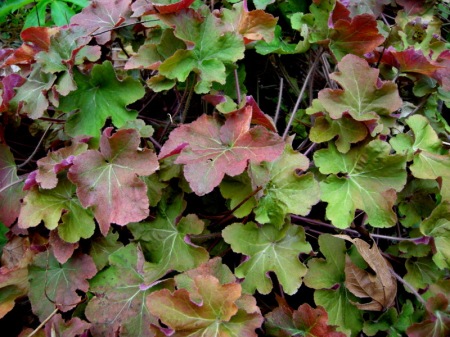 ‘Caramel’ heuchera continues to change from one beautiful hue to the next through out the winter.
‘Caramel’ heuchera continues to change from one beautiful hue to the next through out the winter.
.
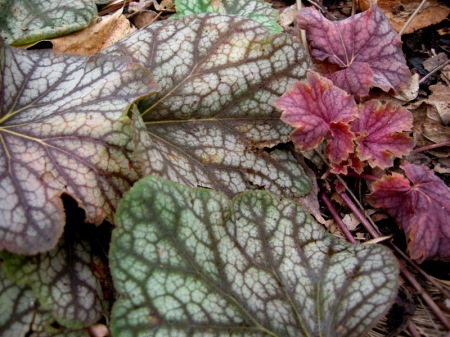 ‘Green Spice’ is new to my garden this year and looks like a winner.
‘Green Spice’ is new to my garden this year and looks like a winner.
.
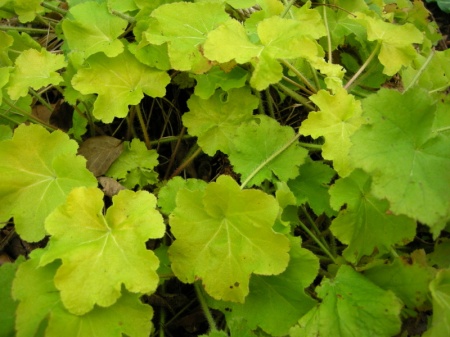 ‘Citronelle’ is a customer favorite for brightening dark corners.
‘Citronelle’ is a customer favorite for brightening dark corners.
You know I couldn’t resist showing you a few snowdrops:
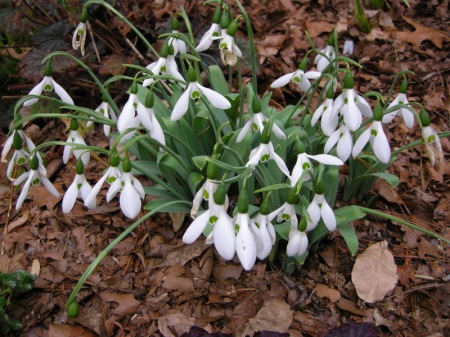 ‘Potter’s Prelude’, a fall-bloomimg snowdrop cultivar, is getting to the end of its bloom period which began in mid-November.
‘Potter’s Prelude’, a fall-bloomimg snowdrop cultivar, is getting to the end of its bloom period which began in mid-November.
.
 A clump of early blooming giant snowdrops, Galanthus elwesii, hides in the Japanese holly ferns and hellebores.
A clump of early blooming giant snowdrops, Galanthus elwesii, hides in the Japanese holly ferns and hellebores.
Except during the heart of the summer when they are dormant, hardy cyclamen are stars in my garden. I find their highly variable leaf patterns endlessly fascinating. For more information on hardy cyclamen, click here.
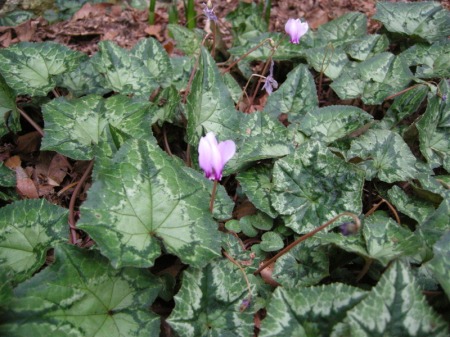 The last few blooms on fall-blooming hardy cyclamen, C. hederifolium, which began blooming at the end of August.
The last few blooms on fall-blooming hardy cyclamen, C. hederifolium, which began blooming at the end of August.
.
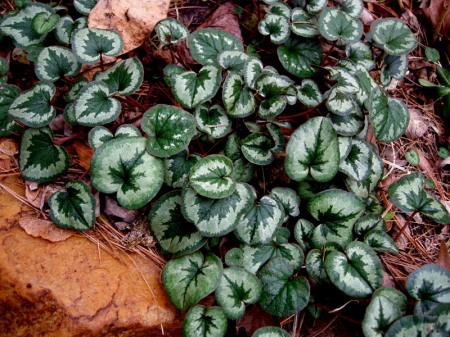 Spring-blooming hardy cyclamen, C. coum, doesn’t need flowers to attract attention.
Spring-blooming hardy cyclamen, C. coum, doesn’t need flowers to attract attention.
Here are some more late fall stars that might surprise you:
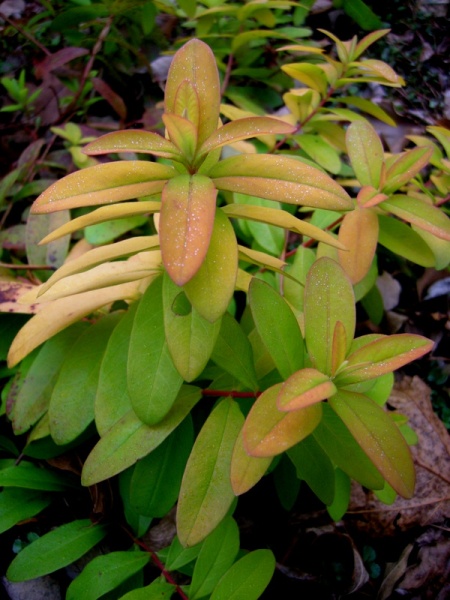 ‘Brigadoon’ St. John’s wort always takes on this lovely peach color for the winter.
‘Brigadoon’ St. John’s wort always takes on this lovely peach color for the winter.
.
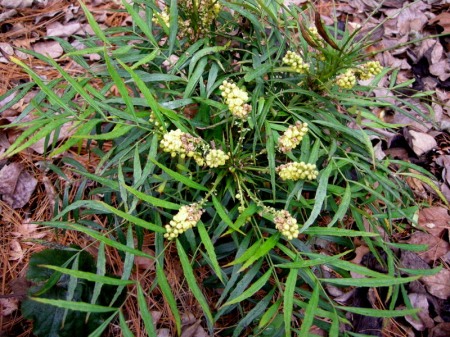 This new mahonia called ‘Soft Caress’ was given to me by the breeders at the Southern Living Plant Collection to trial in my garden. It is evergreen, blooms now, and is hardy to zone 7. For more information, click here. I have high hopes for it because I have since seen it in two other local gardens.
This new mahonia called ‘Soft Caress’ was given to me by the breeders at the Southern Living Plant Collection to trial in my garden. It is evergreen, blooms now, and is hardy to zone 7. For more information, click here. I have high hopes for it because I have since seen it in two other local gardens.
.
 This sedum always turns a lovely burgundy in the fall. Unfortunately, I don’t know its exact name.
This sedum always turns a lovely burgundy in the fall. Unfortunately, I don’t know its exact name.
.
 Bigroot geranium, G. macrorrhizum, takes on red and pink tones for the winter.
Bigroot geranium, G. macrorrhizum, takes on red and pink tones for the winter.
.
 ‘Black Scallop’ ajuga has quickly become one of my favorite groundcovers because its dark purple leaves remain shiny and beautiful through the winter.
‘Black Scallop’ ajuga has quickly become one of my favorite groundcovers because its dark purple leaves remain shiny and beautiful through the winter.
You may be wondering why I would limit myself to one trip outside for photos for this post. Every article that you read here takes me at least a full day to compose, including the photography, the research, the writing, and the editing. I wanted to see if I could cut that back to a few hours and still produce a quality product, and I believe I have been largely successful. It would only work for a post like this though where no significant supporting research was required.
Enjoy, Carolyn
Nursery Happenings: Carolyn’s Shade Gardens is a retail nursery located in Bryn Mawr, PA. The only plants that we mail order are snowdrops and miniature hostas. The nursery is closed until spring 2013. Thanks for a great year.
If you are within visiting distance and would like to receive catalogues and information about customer events, please send your full name and phone number to carolynsshadegardens@verizon.net. Subscribing to my blog does not sign you up to receive this information.
Facebook: Carolyn’s Shade Gardens has a Facebook page where I post single photos, garden tips, and other information that doesn’t fit into a blog post. You can look at my Facebook page here or click the Like button on my right sidebar here.
Notes: Every word that appears in orange on my blog is a link that you can click for more information. If you want to return to my blog’s homepage to access the sidebar information (catalogues, previous articles, etc.) or to subscribe to my blog, just click here.
